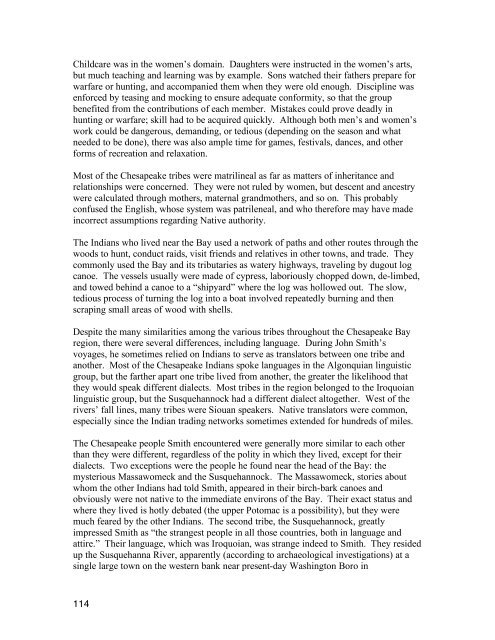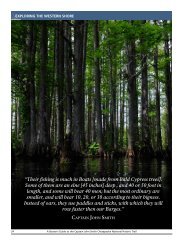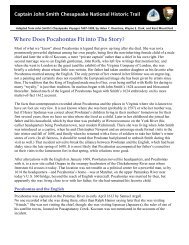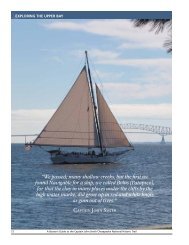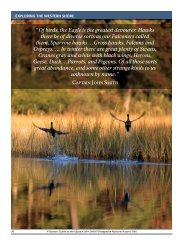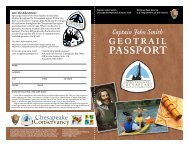Draft Interpretive Plan Join the adventure! - Captain John Smith ...
Draft Interpretive Plan Join the adventure! - Captain John Smith ...
Draft Interpretive Plan Join the adventure! - Captain John Smith ...
You also want an ePaper? Increase the reach of your titles
YUMPU automatically turns print PDFs into web optimized ePapers that Google loves.
Childcare was in <strong>the</strong> women’s domain. Daughters were instructed in <strong>the</strong> women’s arts,<br />
but much teaching and learning was by example. Sons watched <strong>the</strong>ir fa<strong>the</strong>rs prepare for<br />
warfare or hunting, and accompanied <strong>the</strong>m when <strong>the</strong>y were old enough. Discipline was<br />
enforced by teasing and mocking to ensure adequate conformity, so that <strong>the</strong> group<br />
benefited from <strong>the</strong> contributions of each member. Mistakes could prove deadly in<br />
hunting or warfare; skill had to be acquired quickly. Although both men’s and women’s<br />
work could be dangerous, demanding, or tedious (depending on <strong>the</strong> season and what<br />
needed to be done), <strong>the</strong>re was also ample time for games, festivals, dances, and o<strong>the</strong>r<br />
forms of recreation and relaxation.<br />
Most of <strong>the</strong> Chesapeake tribes were matrilineal as far as matters of inheritance and<br />
relationships were concerned. They were not ruled by women, but descent and ancestry<br />
were calculated through mo<strong>the</strong>rs, maternal grandmo<strong>the</strong>rs, and so on. This probably<br />
confused <strong>the</strong> English, whose system was patrileneal, and who <strong>the</strong>refore may have made<br />
incorrect assumptions regarding Native authority.<br />
The Indians who lived near <strong>the</strong> Bay used a network of paths and o<strong>the</strong>r routes through <strong>the</strong><br />
woods to hunt, conduct raids, visit friends and relatives in o<strong>the</strong>r towns, and trade. They<br />
commonly used <strong>the</strong> Bay and its tributaries as watery highways, traveling by dugout log<br />
canoe. The vessels usually were made of cypress, laboriously chopped down, de-limbed,<br />
and towed behind a canoe to a “shipyard” where <strong>the</strong> log was hollowed out. The slow,<br />
tedious process of turning <strong>the</strong> log into a boat involved repeatedly burning and <strong>the</strong>n<br />
scraping small areas of wood with shells.<br />
Despite <strong>the</strong> many similarities among <strong>the</strong> various tribes throughout <strong>the</strong> Chesapeake Bay<br />
region, <strong>the</strong>re were several differences, including language. During <strong>John</strong> <strong>Smith</strong>’s<br />
voyages, he sometimes relied on Indians to serve as translators between one tribe and<br />
ano<strong>the</strong>r. Most of <strong>the</strong> Chesapeake Indians spoke languages in <strong>the</strong> Algonquian linguistic<br />
group, but <strong>the</strong> far<strong>the</strong>r apart one tribe lived from ano<strong>the</strong>r, <strong>the</strong> greater <strong>the</strong> likelihood that<br />
<strong>the</strong>y would speak different dialects. Most tribes in <strong>the</strong> region belonged to <strong>the</strong> Iroquoian<br />
linguistic group, but <strong>the</strong> Susquehannock had a different dialect altoge<strong>the</strong>r. West of <strong>the</strong><br />
rivers’ fall lines, many tribes were Siouan speakers. Native translators were common,<br />
especially since <strong>the</strong> Indian trading networks sometimes extended for hundreds of miles.<br />
The Chesapeake people <strong>Smith</strong> encountered were generally more similar to each o<strong>the</strong>r<br />
than <strong>the</strong>y were different, regardless of <strong>the</strong> polity in which <strong>the</strong>y lived, except for <strong>the</strong>ir<br />
dialects. Two exceptions were <strong>the</strong> people he found near <strong>the</strong> head of <strong>the</strong> Bay: <strong>the</strong><br />
mysterious Massawomeck and <strong>the</strong> Susquehannock. The Massawomeck, stories about<br />
whom <strong>the</strong> o<strong>the</strong>r Indians had told <strong>Smith</strong>, appeared in <strong>the</strong>ir birch-bark canoes and<br />
obviously were not native to <strong>the</strong> immediate environs of <strong>the</strong> Bay. Their exact status and<br />
where <strong>the</strong>y lived is hotly debated (<strong>the</strong> upper Potomac is a possibility), but <strong>the</strong>y were<br />
much feared by <strong>the</strong> o<strong>the</strong>r Indians. The second tribe, <strong>the</strong> Susquehannock, greatly<br />
impressed <strong>Smith</strong> as “<strong>the</strong> strangest people in all those countries, both in language and<br />
attire.” Their language, which was Iroquoian, was strange indeed to <strong>Smith</strong>. They resided<br />
up <strong>the</strong> Susquehanna River, apparently (according to archaeological investigations) at a<br />
single large town on <strong>the</strong> western bank near present-day Washington Boro in<br />
114


